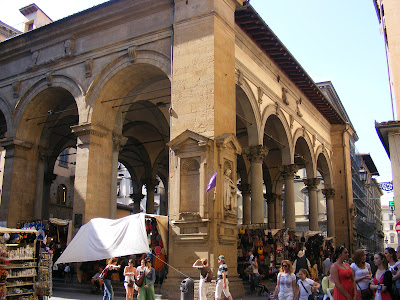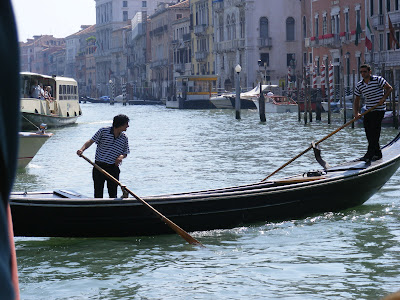Sorry I'm so late. The weather is behaving itself nicely around here for a change, in the 70's. So am I gardening, sunbathing (not that I would) or lounging under an umbrella sipping an ice cold drink? Of course not. I'm out running in the midday sun, training for a half marathon that is sneaking up on me and causing me to worry about the lost training time when we were in Italy. It takes a bit of recovery time to get my baked brain to function again but anyhow, where were we? Oh yes...
It just so happened that shortly after our return to England, the BBC iPlayer had a programme about the Medici family. The narrator was an art critic named Andrew Graham-Dixon. I've never heard of him, but we'll not hold that against him, eh? He spoke pretty good Italian as far as I could tell. He pronounced the name MEH-de-chee, just in case you were wondering (I always have). So here's what else I learned.
It just so happened that shortly after our return to England, the BBC iPlayer had a programme about the Medici family. The narrator was an art critic named Andrew Graham-Dixon. I've never heard of him, but we'll not hold that against him, eh? He spoke pretty good Italian as far as I could tell. He pronounced the name MEH-de-chee, just in case you were wondering (I always have). So here's what else I learned.
The Medici's were the first great modern art collectors and G-Dixon says they changed 'art', but I took it that he meant the 'world of art'. That all comes later. The Medici coat of arms had a simple design using 'palle' or balls on it and the narrator did use this as a reference to their boldness and bravado on occasion. Some have speculated that these palle were meant to symbolise dents in the armour of a valiant knight, to imply this was a noble family, but in fact they represent coins. Giovanni Medici, where the story begins, founded the Medici Bank in 1397, in Florence, Italy.
At that time, bankers were gathered in a market place, their desks a simple table ('banco' means bench). G-Dixon says the custom was for bankers to shout out "I have 30 Florins to be repaid by Christmas!" or "I have 15 Florins to be repaid in two months!" (One of the things I love in Britain is how the fruit and veg men on the street shout out their best deals still!) There was a great deal of risk in lending money and if a banker failed, his table was broken, which is where we get the term 'bankrupt' (and possibly 'broke' as well?). Bankers developed policies to reduce their risk.
One of the Medici policies was not to loan to royalty; royalty never paid their debts! (Between pertinent Medici portraits, buildings and art, the programme filled visual space with scenes from Florence; I particularly remembered seeing a man pushing a rack of clothing a fair distance from a building doorway down to the big market square, just like on the telly. I was sure I snapped his picture, but can I find it? No.)
Of course the Medici's were devout Christians, bound by church law, and money lending was a mortal sin, particularly the collection of interest. Dante's famous work placed usurers in the depths of hell, because it was "an offense against the good of God; the usurer sells nothing and gives nothing for his profit". Dante pictured them sitting in the 7th Circle of Hell, their hands continually moving for all eternity, because they did nothing with their hands in life. Right next to the money lenders would be where you found your blasphemers and your sodomites. (I largely feel this way about bankers these days, so I sort of appreciated this idea).
Of course the church had a get out clause: one could purchase salvation by sponsoring Great Art, say, by commissioning a painting or a statue. This was actual church policy. A successful banker with his greed and the sorrow of his clients' debt was a source of great division and so, G-Dixon said, it was fitting that Medici commissioned in 1401 a work of art for the Baptistry in Florence, the place that brought together all families at the baptism of a child. In this case the art was decorating the front doors with bronze statues. The doors were made by Lorenzo Ghiberti and he did such a swell job -- it took him more than 20 years -- that Michelangelo said they could be the Gates of Paradise, and so they have been known ever since.
Nevertheless, there was still the ancient Christian distrust of wealth -- which seems to have largely disappeared, thanks to ideas associated with 'Protestant work ethic'. Our next man was the son of Giovanni and the narrator dubbed him 'Cosimo the Cautious'. As the head of a very powerful and wealthy family in the time of a democratic Republic, he kept his head down. He dressed plainly, didn't hold many offices and even rode a donkey rather than a horse. Still, political decisions were often made in his house.
Turns out the monastery of San Marco was getting a bit run down and Pope Eugene IV got his friend Cosimo to pay for the complete renovation. G-Dixon mentions the term 'money laundering' here. While he was at it, Cosimo built himself a room in the monastery as his own retreat. There are two notable features of his 'cell'. One is that there is an engraved plaque signed by the Pope, so to speak, a kind of receipt I was thinking, or perhaps a ticket to heaven. It specifies that Cosimo's hands (money) are now washed clean and he has attained salvation. The other is that his cell has not one room, but a second one upstairs, so not as humble as the rest.
In his home, the Palazzo Medici Riccardi, there is found the Magi chapel, where Cosimo commissioned Benozzo Gozzol to paint a fresco of the procession of the three wisemen, bringing their expensive gifts to Christ. G-Dixon shows us the fresco, particularly the portrait of Cosimo as one of the Magi. He points out the blaze of bold colours, the wild animals, the horses wearing gold studded bridles (the equivalent of perhaps a Versace handbag today), and how in Cosimo's private space he celebrates the joy of capitalism and consumables. I was thinking he was practicing his 'spin' as well, making the now perceived link between wealth and wisdom.
The programme then shows us art by Paolo Ucchello, who used mathematical skills to give the illusion of space and create three dimensional paintings. Also Donatello's statue of David with curls and a helmet. This was the first freestanding nude statue since Roman times. I think it looks rather swishy, but apparently the artist 'captured David between puberty and adolescence.' The woman who had the job of cleaning the statue had been at it for 18 months or thereabouts, so I guess she liked it pretty well. She and G-Dixon had a chuckle about what a nice tush he - the statue - has.
These works are thought to have been commissioned by Cosimo, but still being cautious, he kept his more decadent side out of the city. Renaissance Florence was said to be a violent and volatile place and a fellow needs a refuge, a bolthole away from all that. So, we have the Villa di Cafaggiolo, a fortress in the Tuscan countryside where the Medici's escaped from all the tribulations of city life; they eventually had quite a few villas scattered around.
At this point, G-Dixon mentioned turning food into an art form and he had a lively conversation with a chef with sub-titles. The dish was apparently 'Liver loaf', something to do with chicken livers and bread soaked in wine. I'm not making that jump somehow...sure it's liver, but it is art? In any case, eating lots of meat and lots of spices were the mark of a wealthy food budget (La Spezia, a very popular tourist destination on the Med - and a lovely place - means Spice).
NB. Photos don't relate much to the TV programme topics, they are just from our wanderings around Florence (one just to prove I was actually there).










































































